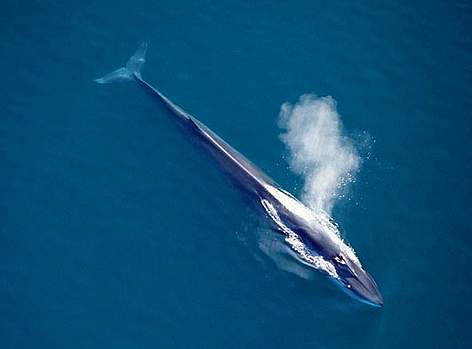
In the late 1980s, as the Cold War faded, the American military began allowing scientists access to its underwater “sound surveillance system.”
Known as SOSUS, it comprised arrays of microphones positioned around the world’s oceans. These microphones were originally meant to detect Soviet submarines, but once biologists and oceanographers got their ears on the equipment, it opened up to them a world of sound that they had previously only dreamed of hearing.
And of all the things they started hearing, few were as compelling as the “52-hertz whale.”
First heard in the North Pacific in 1989, this particular whale’s call was distinctive, because it was much higher than most Blue or Fin whales, which typically fall between 10 and 40 hertz. So to a fellow whale, the 52-hertz whale delivered a comically high, positively pipsqueak-ish song.
Scientists tracked the whale for more than a decade. They followed its migration up and down the Pacific, as it sang and sang, with no apparent response to its desperate call. Was its higher song inaudible to other whales? What it an outcast because of its unusually high voice? Was this the loneliest whale in the world?

Google that phrase – the loneliest whale in the world – and you will see just how much attention this enigmatic whale has garnered. The story has a definite anthropomorphic appeal to it: whales are gentle giants to begin with, historical victims of human greed and progress. It’s easy to feel sympathetic.
But is the whale actually lonely?
It might be that when we see solitude like that – a large creature in an infinitely larger ocean, calling out on a frequency no other whale is using – that all we see is our own loneliness reflected back at us. Or at least, our own fear of being alone. Solitude is uncomfortable for many people, because it shares a front door with loneliness.
Tom Richards has plenty of projects worth hearing (see week 63 and week 117) but his most recent project, a series of pieces improvised on a recently-acquired piano, pulls the listener right along the knife edge between solitude and loneliness. As he puts it: “It feels like there is a thin membrane separating the stillness of quiet tranquility and the darkness of existential dread.”
I can easily imagine the 52-hertz whale being a mascot for either of those options: quiet tranquility or existential dread.
Equally easily, I can imagine this song, the final track from Richards’ album Carbon, as the soundtrack for that whale’s tranquil (lonely?) travels through the Pacific Ocean.
What makes this a beautiful song:
1. The track opens with almost 10 seconds of near-silence; only the soft creak of the piano stool indicates that anyone else is on the other side of the microphone.
2. While some notes ring out softly, some are muted, while others buzz and sizzle. This is a result of Richards’ treatment of the piano, which he describes as collecting “jangly and rubbery bits” and attaching them to the strings before recording. It makes me imagine a wind-up toy so old and well-used that winding it up one more time might destroy it.
3. Although the tempo is fairly loose, we are mostly in three-quarter time signature here. This makes me imagine that my previously-imagined wind-up toy is dancing a waltz by himself. Whether this implies happy solitude or crushing loneliness is, of course, up to you.
Recommended listening activity:
Seeing how strongly you can blow on a candle without actually blowing it out.